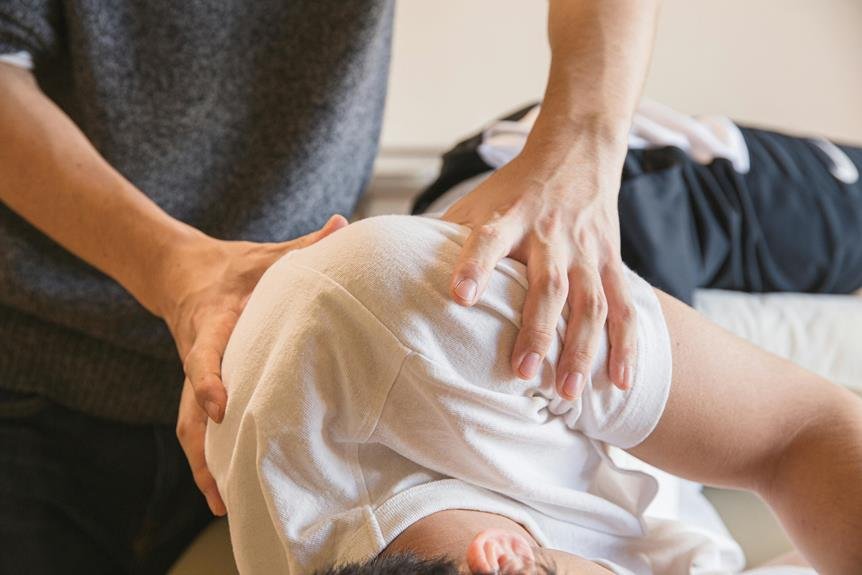Expert Tips for Finding Relief From Chronic Back Pain After 50
In the uphill battle against chronic back pain after 50, navigating the maze of remedies can feel like searching for a needle in a haystack.
But fear not, as there are reliable strategies to ease your discomfort and regain control over your quality of life.
By implementing targeted lifestyle adjustments and seeking guidance from seasoned professionals, you can unlock a path to relief that is tailored to your specific needs.
Understanding Chronic Back Pain
If you suffer from chronic back pain, understanding the underlying causes can help you find effective relief. Chronic back pain can be caused by various factors such as muscle strain, poor posture, arthritis, or herniated discs. Muscle strain is a common cause, often resulting from heavy lifting, sudden movements, or poor lifting techniques. Poor posture, such as slouching while sitting or standing, can put strain on your back muscles and lead to chronic pain over time. Arthritis, a condition that causes inflammation in the joints, can also affect the back and result in persistent discomfort. Additionally, herniated discs, which occur when the cushioning between the vertebrae bulges out, can press on nerves and cause chronic back pain.
To effectively manage chronic back pain, it's crucial to identify the specific cause or causes contributing to your discomfort. Consulting with a healthcare professional can help pinpoint the underlying issue and determine the most suitable treatment plan for your condition. By understanding the root cause of your chronic back pain, you can take proactive steps towards finding relief and improving your overall quality of life.
Importance of Proper Posture
Maintaining proper posture is crucial for alleviating chronic back pain. Adjusting your chair ergonomically and practicing spine alignment techniques can significantly reduce discomfort.
Ergonomic Chair Setup
To achieve proper posture and alleviate back pain, ensure your ergonomic chair is set up correctly. Start by adjusting the chair height so that your feet rest flat on the floor and your knees are at a 90-degree angle.
Position the chair's backrest to support the natural curve of your spine, keeping it upright and avoiding slouching. Your arms should bend comfortably at a 90-degree angle when resting on the armrests.
Make sure the chair is close enough to your desk to avoid leaning forward or straining your back. Additionally, consider using a cushion for extra lumbar support if needed.
Spine Alignment Techniques
How can you ensure your spine alignment through proper posture techniques?
Maintaining good posture is crucial for spine alignment and back health, especially as you age. Start by sitting or standing up straight with your shoulders back and relaxed. Keep your head level, aligning it with your spine, and avoid slouching or hunching forward.
When sitting, make sure your feet are flat on the floor and your knees are at a right angle. Invest in a supportive chair that promotes proper alignment and consider using a cushion for extra lumbar support.
Regularly check your posture throughout the day and make adjustments as needed to prevent strain on your spine and reduce chronic back pain.
Gentle Exercise Routines
To find relief from chronic back pain after 50, consider incorporating low-impact workouts and stretching routines into your daily exercise regimen.
These gentle exercises can help strengthen your back muscles, improve flexibility, and alleviate discomfort.
Low-Impact Workouts for Seniors
If you're a senior looking to stay active and maintain your health, gentle exercise routines known as low-impact workouts can be an excellent option to consider. These workouts are designed to be easy on your joints while still providing numerous health benefits.
Activities like walking, swimming, cycling, or even gentle yoga can help improve your strength, flexibility, and overall well-being without putting too much strain on your body. Low-impact exercises are great for seniors as they can reduce the risk of injury and are generally easier to recover from compared to high-impact activities.
Remember to start slowly, listen to your body, and gradually increase the intensity to enjoy the full benefits of these gentle workouts.
Stretching for Back Health
Incorporate gentle stretching exercises into your daily routine to promote back health and flexibility.
Start with a simple hamstring stretch: while seated, extend one leg forward and lean slightly forward, feeling the stretch in the back of your thigh. Hold for 15-30 seconds and switch legs.
Additionally, try a gentle lower back stretch by lying on your back, bringing one knee towards your chest, and holding it for 20 seconds before switching sides.
Incorporating yoga poses like the cat-cow stretch can also help alleviate back pain by improving spinal flexibility. Remember to breathe deeply and listen to your body, avoiding any movements that cause pain.
Consistency is key, so aim to stretch daily for long-term back health benefits.
Lifestyle Modifications for Pain Relief
Making gradual changes to your daily routines and habits can significantly contribute to alleviating chronic back pain. One key modification is to practice good posture while sitting, standing, and walking. Slouching puts extra strain on your back, so make a conscious effort to sit and stand up straight.
Another lifestyle adjustment is to maintain a healthy weight through a balanced diet and regular exercise. Excess weight can exacerbate back pain by putting pressure on your spine. Additionally, incorporating low-impact exercises like swimming or walking into your routine can help strengthen your back muscles and improve flexibility.
Furthermore, it's essential to prioritize quality sleep to allow your body to repair and rejuvenate. Invest in a supportive mattress and pillow to ensure proper spinal alignment while you sleep. Stress management techniques such as meditation, deep breathing, or yoga can also aid in reducing muscle tension and alleviating back pain.
Benefits of Physical Therapy
Physical therapy can play a crucial role in managing and reducing chronic back pain by targeting specific exercises and techniques to improve strength, flexibility, and overall function. By working with a physical therapist, you can receive personalized treatment plans tailored to your needs. These plans often include a combination of stretching, strengthening exercises, manual therapy, and posture training to help alleviate back pain.
One of the key benefits of physical therapy is that it can help you regain mobility and function in your daily activities. Through targeted exercises, physical therapy aims to strengthen the muscles supporting your spine, improve your posture, and enhance your overall flexibility. Additionally, physical therapy can teach you proper body mechanics to prevent future injuries and reduce the risk of recurring back pain episodes.
Consistency is key when it comes to physical therapy. By actively participating in your treatment plan and following the guidance of your physical therapist, you can experience long-term relief from chronic back pain and improve your quality of life.
Mind-Body Techniques for Relaxation
To enhance your overall well-being and complement the benefits of physical therapy for chronic back pain relief, consider exploring mind-body techniques for relaxation. Incorporating practices such as meditation, deep breathing exercises, progressive muscle relaxation, or guided imagery can help alleviate stress and tension that contribute to back pain. These techniques not only promote relaxation but also enhance your body's ability to heal and cope with discomfort.
Meditation involves focusing your mind and eliminating distracting thoughts, which can help reduce the perception of pain and improve your mood. Deep breathing exercises promote oxygen flow, relax muscles, and calm the mind, easing both physical and emotional tension. Progressive muscle relaxation teaches you to tense and then release each muscle group, promoting a sense of relaxation throughout your body. Guided imagery uses visualization to create calming mental images that can reduce stress and enhance relaxation.
Incorporating Ergonomic Changes
Consider implementing ergonomic changes to your daily routine to alleviate chronic back pain and improve your overall comfort. Start by adjusting the height of your chair and ensuring that your feet are flat on the floor while sitting. This simple change can help maintain the natural curve of your spine and reduce strain on your back muscles. Additionally, position your computer screen at eye level to prevent slouching and neck strain.
When lifting objects, remember to bend at the knees and lift with your legs instead of your back. This technique can significantly decrease the pressure on your spine and prevent unnecessary pain. Investing in a supportive mattress and pillows can also make a big difference in relieving back pain while you sleep.
Furthermore, consider using a lumbar support cushion or a standing desk to promote good posture throughout the day. These ergonomic adjustments may take some getting used to, but they can have a lasting impact on your back health and overall well-being.
Seeking Professional Help
If ergonomic changes fail to alleviate your chronic back pain, it may be time to consult a medical professional for further assistance. Chronic back pain can be complex and may require the expertise of healthcare providers such as physiotherapists, chiropractors, or pain management specialists. These professionals can conduct a thorough assessment to determine the root cause of your pain and develop a personalized treatment plan to address it effectively.
When seeking professional help for chronic back pain, start by consulting your primary care physician. They can provide referrals to specialists and coordinate your care to ensure you receive comprehensive treatment. Physiotherapists specialize in exercises and techniques to improve strength, flexibility, and overall back health. Chiropractors focus on spinal adjustments to alleviate pain and improve function. Pain management specialists offer a range of treatments, including medications, injections, and procedures to manage chronic back pain.
Frequently Asked Questions
Can Chronic Back Pain After 50 Be Completely Cured, or Is It Something That Needs to Be Managed Long-Term?
Chronic back pain after 50 may not have a complete cure, often requiring long-term management. By adopting lifestyle changes, regular exercise, proper posture, and seeking professional help, you can effectively alleviate and control the discomfort.
Are There Any Specific Dietary Changes or Supplements That Can Help Alleviate Chronic Back Pain in Older Adults?
To help alleviate chronic back pain in older adults, consider dietary changes and supplements. Opt for an anti-inflammatory diet rich in fruits, veggies, and Omega-3s. Supplements like glucosamine and turmeric may also provide relief. Always consult your doctor first.
How Can Social Support and Mental Health Play a Role in Managing Chronic Back Pain After 50?
Supportive relationships and a positive mindset can greatly impact your ability to cope with chronic back pain after 50. Engaging in activities you enjoy, seeking emotional support, and practicing stress management techniques can improve your overall well-being.
Are There Any Alternative Treatments or Therapies That Have Been Found to Be Effective in Relieving Chronic Back Pain in Older Individuals?
When dealing with chronic back pain after 50, consider alternative treatments like acupuncture, yoga, and chiropractic care. These therapies have shown effectiveness in providing relief for older individuals struggling with ongoing back discomfort.
Can Chronic Back Pain in Older Adults Be a Sign of More Serious Underlying Health Issues, and if So, What Should One Look Out For?
Chronic back pain in older adults can be a sign of serious underlying health issues. Look out for symptoms like numbness, weakness, or bowel/bladder changes. Consult a healthcare provider for proper evaluation and management.
Conclusion
So, remember, chronic back pain after 50 doesn't have to control your life.
By incorporating proper posture, gentle exercise, lifestyle modifications, physical therapy, and mind-body techniques, you can find relief and improve your quality of life.
Just like a garden that needs tender care and attention to flourish, your body also needs nurturing and support to thrive.
Take the time to invest in yourself and watch as your pain gradually fades away, leaving room for growth and healing.






